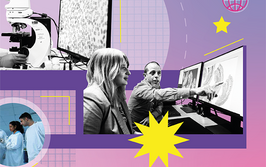Overcoming the Limitations of Light
New live cell tomography technology allows the observation of cells in their native environments in real-time
At a Glance
- Current microscopy techniques face obstacles in sample preparation, invasiveness and image quality
- A new form of live cell imaging combines holography with rotational scanning to generate 3D tomographic images of cells
- The new technique can be used on cells in their native environment, without requiring staining or other invasive sample preparation
- The potential of live cell tomography ranges from the subcellular to the systemic and offers time and money savings over traditional imaging methods
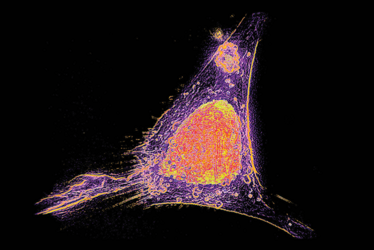
3D image of a live lymphatic endothelial cell
The pioneers of microscopy might not have believed it if anyone had told them that, not too far into the future, it would be light itself, rather than technology, that limited our ability to see the tiniest parts of our world. Until recently, the diffraction barrier made it impossible to look inside a living cell without damaging it, even using the most expensive, state of the art devices. Traditional fluorescence microscopy relies on complicated procedures that can be difficult (risking the introduction of errors) and time consuming (as much as 72 hours of preparation) to set up. These methods can be invasive to the cells; they are at risk of damage, data could be inaccurate and results are limited. Not all techniques permit three-dimensional imaging, and many lack contrast or require chemical or biological staining procedures.
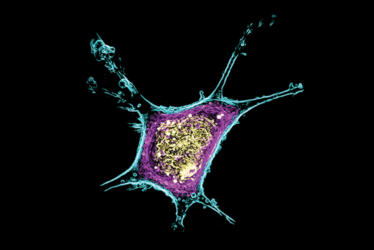
3D image of a live fibroblastic reticular cell
To tackle these obstacles, a group of Swiss researchers have developed a new form of live cell imaging. They’ve created a microscope to test their principle, the 3D Cell Explorer (Nanolive, Ecublens, Switzerland), which overcomes the inherent diffraction limit of light through a combination of holographic microscopy and rotational scanning. Using holography allows cells to be examined in their native environment, without the need for labels or stains; rotational scanning permits 3D reconstructions of the images at a resolution well below the diffraction limit (1). The technology resembles computed tomography (CT) scanning for human bodies, but the Cell Explorer looks at the way light propagates through single cells, generating a quantitative tomographic image of the living cell. Unlike a CT scan for the human body, though, it generates the image instantly – so users can effectively “travel” through a cell in 3D on a screen, process the data in the cloud and compare it quantitatively with previously acquired information. Live cell tomography allows researchers to see and precisely measure the impact of drugs and other stimuli on cells, thus enabling completely new fields of research into human health.
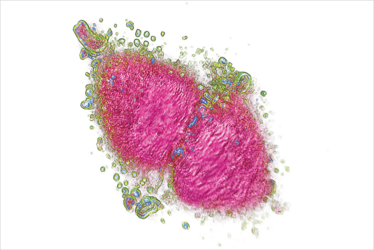
3D image of a fixed dividing cancer cell
Inspired imaging
Yann Cotte, formerly of the École Polytechnique Fédérale de Lausanne (EPFL), Switzerland, began by conducting theoretical research into high-resolution methods for digital holographic microscopy. Ultimately, his proposed theory extended the limit of resolution with coherent illumination by 40 percent (2) or even 70 percent (3). Asked to undertake practical experiments on cells, the results were promising enough to springboard more intensive research and additional cell-based experiments in which Cotte and his colleagues were able to demonstrate imaging resolution below the 100 nm barrier without the need for markers (1).
The result of this research is the 3D Cell Explorer, of which there are currently two prototypes in use. The first prototype was placed in the Laboratory of Lymphatic and Cancer Bioengineering at EPFL, where Melody Swartz has been using it to study the ways in which immune cells interact with antigen presenting cells and what morphological changes can be observed during this process. Examining the interactions between cancer, immune and lymphatic endothelial cells has successfully yielded very clear images and videos of cells (4). The laboratory is also using the technology to study the methods immune cells use to kill tumor cells and the morphological changes that occur during this process.
The second prototype, recently installed at Harvard University, Cambridge, MA, USA, is currently being used to study cancer stem cells (CSCs). Clemens Grassberger of Harvard Medical School and the Department of Radiation Oncology, Massachusetts General Hospital, aims to develop a physical marker to identify CSCs in vivo and to continuously follow the responses of different cell populations to photon and proton irradiation in combination with chemotherapy – results that could make a big difference to patient therapies.
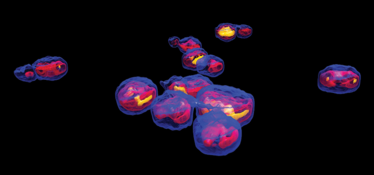
3D image of live saccharomyces cerevisiae cells
Promises for pathology
Live cell tomography is a new tool for discovering the secrets of the cell, and we are just at the beginning of exploring its potential fields of application. It allows the measurement of cellular processes and kinetics in real-time, which enables multi-parameter analysis at the single-cell and subcellular scales. This kind of data can provide us with new information on cell morphology, division, differentiation, remodeling, apoptosis, and intracellular trafficking. It’s not only useful for tracking the behaviors of individual cells, though; the technology can be used to examine cell-cell interactions or to monitor the effects of drugs. Because the cells can be observed in their natural environment, without the need for staining or other manipulation, live cell tomography even allows the monitoring of procedures such as in vitro fertilization.
It’s not just for cells in situ, though – an additional confluency mode, such as the one available on the 3D Cell Explorer, can enable the imaging of unstained thin tissue slides as well. By using a mode like this, pathologists could directly evaluate, for instance, the morphology of cancerous tissue sections, saving the time and money that would normally be required for staining.
The focus for the future lies on comprehensive visualization in three dimensions and even through time, with the ultimate goal of enabling routine laboratory analyses that are quicker, less expensive, and more reliable than those available today.
- Y Cotte, et al., “Marker-free phase nanoscopy”, Nature Photon, 7, 113–117 (2013).
- Y Cotte, et al., “Sub-Rayleigh resolutionby phase imaging”, Opt Lett, 35, 2176–2178 (2010). PMID: 20596185.
- Y Cotte, et al., “Beyond the lateral resolution limit by phase imaging”, J Biomed Opt, 16, 106007-1–1060076 (2011). PMID: 22029354.
- Nanolive, “Gallery”. Available at: bit.ly/1vEpOFa. Accessed February 11, 2015.

While obtaining degrees in biology from the University of Alberta and biochemistry from Penn State College of Medicine, I worked as a freelance science and medical writer. I was able to hone my skills in research, presentation and scientific writing by assembling grants and journal articles, speaking at international conferences, and consulting on topics ranging from medical education to comic book science. As much as I’ve enjoyed designing new bacteria and plausible superheroes, though, I’m more pleased than ever to be at Texere, using my writing and editing skills to create great content for a professional audience.








